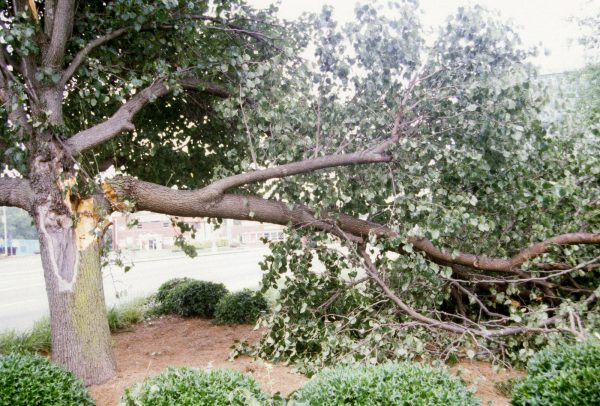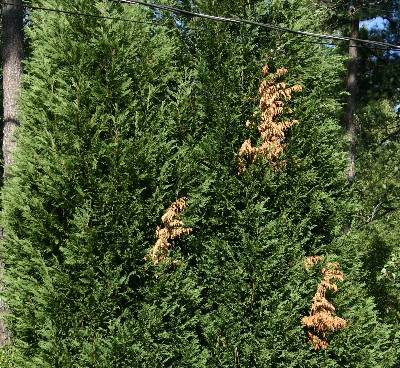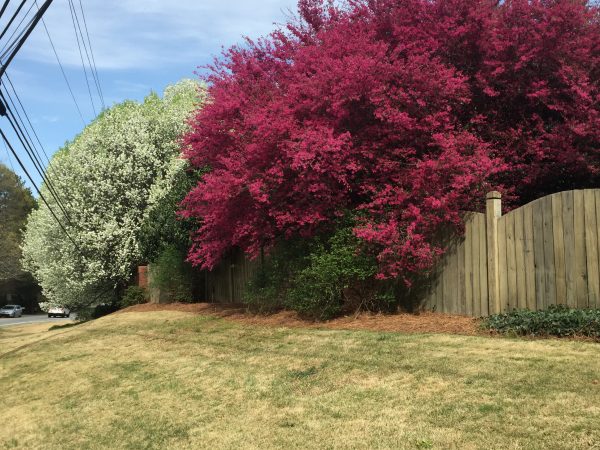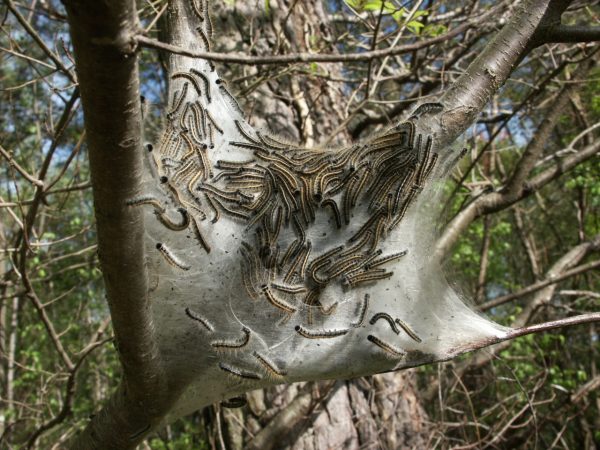Bradford Pear – Substitutes and Alternatives

Homeowners often complain about their ‘Bradford’ pear problems. “The flowers stink!”, “The branches fall apart!”.
If you have such a tree and want to replace it, there are lots of alternatives.
My absolute top choice would be a tree-type crapemyrtle. They are tough, fast-growing and bear flowers in a variety of colors.
Here’s a good list of crapemyrtle varieties and their descriptions.
Click here for Pictures of Native Alternatives for Bradford Pear (described below)
Red buckeye – Aesculus pavia
Red buckeye is a clump-forming shrub or small tree that typically grows 10-20’ tall. Showy 4-10” long panicles of red to orange-red tubular flowers appear in spring and attract hummingbirds. Shiny, dark green leaves are attractive in spring and early summer, but usually begin to decline by August. Seeds are poisonous and are avoided by most wildlife.
Serviceberry – Amelanchier arborea
This large shrub or small tree typically grows 15-25′ tall and features good fall color and showy, slightly fragrant, white flowers in early spring. Flowers give way to small, round green berries which turn red and finally mature to a dark purplish-black in early summer. The edible berries resemble blueberries in size and color and are often used in jams, jellies and pies. Best placed with dark or shaded backdrops which tend to highlight the form, flowers and fall color of the plant.
American hornbeam – Carpinus caroliniana
An attractively shaped, low-maintenance understory tree for shady sites, this Missouri native is a slow-growing, small to medium-sized (20-35′ tall) tree with an attractive globular form. The smooth, gray trunk and larger branches of a mature tree exhibit a distinctive muscle-like fluting that has given rise to another common name of musclewood for this tree. Dark green leaves often produce respectable shades of yellow, orange and red in fall.
Redbud – Cercis canadensis
This popular Missouri native typically grows 20-30’ tall with a slightly larger spread. It is particularly noted for its stunning rose-purple flowers which cover its bare branches in early spring (March-April). It performs best in moderately fertile soils with regular and consistent moisture but is intolerant of wet or poorly drained soils. Since this tree does not transplant well, it should be planted when young and left undisturbed.
Fringe tree – Chionanthus virginicus
Plant this small tree (typically 12 to 20′ tall) in full sun for the best flowers, which are intensely fragrant and can be smelled before the tree is seen. The unusual delicate ‘strap-like’ flower petals hang from the ends of stout branches. At the peak of its bloom the whitest white petals cover and hang from the tree rivaling a snowstorm. Good yellow fall color.
Yellowwood – Cladrastis kentukea
Excellent, low-maintenance, small shade tree (30-50′ tall) for residential lawns, particularly on smaller properties. The roots go deep, so other plants may be easily grown underneath. It features intensely fragrant, wisteria-like, white flowers in clusters 10-15″ long that virtually cover a mature tree in late spring. Good yellow fall color.
Pagoda dogwood – Cornus alternifolia
Small deciduous tree or large multi-stemmed shrub (15-25’ tall) with distinctive tiered (layered) horizontal branching which is upward-turned at the tips reminiscent of a pagoda. Small, fragrant, yellowish-white flowers bloom in late spring (May-June). Flowers give way to bluish-black fruits on red stalks. Leaves turn reddish-purple often tinted yellow or green in fall. Attracts birds and butterflies.
Flowering dogwood – Cornus florida
Though this Missouri native dogwood grows as an understory tree in shady areas, many cultivars were developed for planting in yards where the numerous flower bracts and berries are unrivaled. The crimson fall leaf color and tight, blocky bark are also unique. Though transplanting a native tree may be tempting, the fine cultivars available are a better choice. In the East, a disease, a type of anthracnose, has killed many dogwoods…but not in Missouri.
American smoke tree – Cotinus obovatus
This small tree or upright shrub (20-30′ tall) gets its common name from the billowy hairs (attached to elongated stalks on the spent flower clusters) which turn a smoky pink to purplish pink in summer, thus covering the tree with fluffy, hazy, smoke-like puffs. Bluish green leaves turn a variety of colors in the fall (including yellow, red, orange and reddish purple) and produce some of the best fall color of any of the native American trees and shrubs.
Green hawthorn – Crataegus viridis
Green hawthorns are beautiful flowering trees. They grow 20-35’ tall and are largely thornless. Flowers are followed by small red fruits that ripen in September and usually persist on the tree well into winter. Leaves turn purple to red in fall. Attractive to birds and butterflies.
Umbrella tree – Magnolia tripetala
The long, shiny green leaves (24″ long and to 10″ wide) of this deciduous magnolia appear in whorl-like clusters at the stem tips, purportedly resembling the spokes of an umbrella. It is a small (30′ tall) understory tree that is often multi-trunked. Large, malodorus but showy, creamy white flowers (6-10″ across) bloom in spring shortly after the leaves emerge. Flowers are followed by cone-like pink fruits that ripen in fall.
Black gum – Nyssa sylvatica
This Missouri native is a stately tree with a straight trunk and rounded crown (more pyramidal when young) that typically grows 30-50′ tall. Although the flowers are not showy, they are an excellent nectar source for bees while the fruits, which are technically edible but quite sour, are attractive to birds and wildlife. Good tree for wet, periodically flooded conditions. Spectacular scarlet fall color. It is NOT related to sweet gum.
Eastern hop hornbeam – Ostrya virginiana
This interesting small tree (25-40′ tall) features female catkins, followed by drooping clusters of sac-like, seed-bearing pods which, as the common name suggests, somewhat resemble the fruit of hops. Also commonly called ironwood because of its extremely hard and dense wood.
Carolina buckthorn – Rhamnus caroliniana
This deciduous shrub or small tree (10-15′ tall) is noted for its bright shiny green leaves and edible fruits. Leaves retain green color long into fall before eventually turning an unexciting yellow-green. Somewhat insignificant, creamy-green flowers are followed by edible berry-like drupes (1/3″ across) which ripen to a very showy red before finally maturing in September-October to black. Birds are very attracted to the fruit. Also, attracts butterflies. Some authorities call this species Frangula caroliniana.
Rusty blackhaw viburnum – Viburnum rufidulum
Also called Southern blackhaw, this is a suckering shrub or small tree that typically grows 10-20’ tall. The glossy, dark green leaves are leathery and the undersides are rusty brown as are the buds and young stems. Tiny white flowers in showy rounded clusters bloom in spring and are followed by clusters of edible, dark blue berries that ripen in September-October. Birds are attracted to the fruit. Foliage turns reddish purple in fall.
Here are some other choices
Japanese zelkova – very tolerant to wind, drought and air pollution and provides a good amount of shade. It is great as a yard or street tree due to its attractive vase-like profile and can double its height in 4-6 years.
Red maple – brings year-round red color to your yard and display deep scarlet leaves in the fall. Also a fast-growing tree, it can grow anywhere and provides a good amount of shade. Produces flower and fruit in the spring before most other species.
Chinese pistache – popular ornamental tree that is very long-lasting and has a very hard wood. It is deep rooted, drought-resistant and, very importantly, disease and insect-free. It grows 2-3 feet a year into a medium-sized shady tree with spectacular fall colors.
Kousa dogwoods – small white-bloomers that are more tolerant of poor soil and full sun than native American dogwoods; disease-resistant
‘Aurora’ dogwood – a cross between an American dogwood and a Kousa dogwood.
‘Sugar Tyme’ crabapple -18-foot, upright durable tree that flowers white in April and gets small red fruits in fall.
American fringetree – gets hanging, white, confetti-like flowers in May and yellow fall foliage on a tree that grows about 20 feet tall and wide in 20 years.

who wants this?













